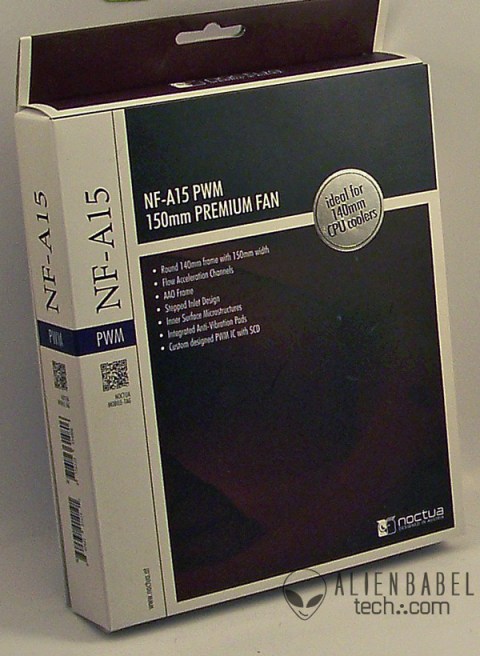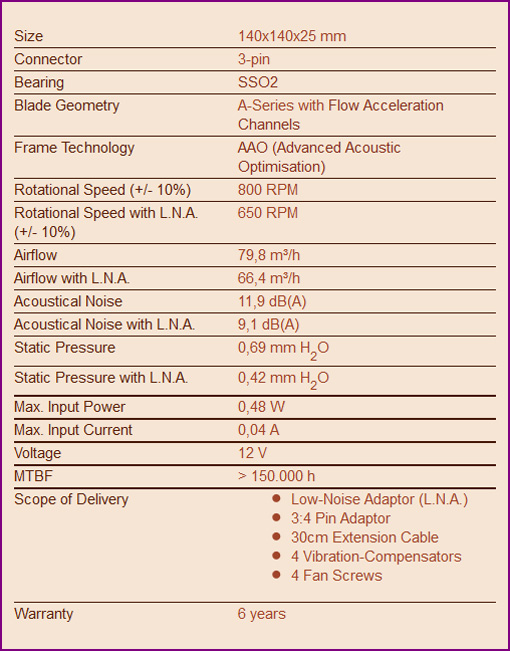Noctua’s NF-A15 PWM and NF-A14 140mm Premium fans – Quiet and Cool!
Specifications and Unboxing
Let’s look at some of the refinements of the NF-A15 PWM Premium fan and two NF-A14 fans. All three fans we tested use an attached 20cm cable and all of the kits include a 30cm extension with black sleeving. We will see excellent specifications regarding airflow and low noise as well as a well thought-out packaging, accessories, and instructions on the box and at Noctua’s website.
The NF-A Series fans are available in three models: the NF-A15 PWM, NF-A14 FLX and NF-A14 ULN. The NF-A15 PWM features a round-style 140x150mm frame with 120mm mounting points. It operates from about 300rpm to 1200rpm which makes it ideal for use on CPU coolers and an excellent PWM replacement for our NH-DH14’s original non-power managed 140mm NF-P14 fan.![NHDH14]](http://i2.wp.com/alienbabeltech.com/main/wp-content/uploads/2013/03/NHDH14.jpg?resize=304%2C300)
It is possible to run the Noctua flagship CPU cooler with only the center fan, and low noise adapters can also be used to slow the fans rpm into inaudibility (from 1200rpm down to 900rpm at 13.8dBA) although your would not want to be aiming for a high overclock while lowering fan speeds. The NH-DH14 is also flexible in that if you have room, a third 120mm cooling fan can easily be clipped to the other side of the heatsink for Push-Pull-Push although very little improvement will be found in actual temperatures.
Noctua NF-A15 PWM 140x150mm fan
Noctua’s NF-A15 PWM round fan is the replacement for the NF-P14 round 140mm fan. Here is what Noctua has to say about it from their own web site:
The NF-A15 is a premium quality quiet 140mm fan with a round frame that complies with Noctua’s AAO (Advanced Acoustic Optimisation) standard. The NF-A15’s frame features 120mm mounting holes (105mm spacing) and has been enlarged to 150mm width in order to provide superior performance on today’s high-end CPU coolers. Featuring sophisticated aerodynamic design measures such as Flow Acceleration Channels, the NF-A15 further improves the renowned quiet cooling performance of the award-winning NF-P14. Noctua’s custom designed PWM IC for fully automatic speed control and reference class SSO2 bearings guarantee superb running smoothness and excellent long-term stability. Topped off with modular cabling, a Low-Noise Adaptor and 6 years manufacturer’s warranty, the NF-A15 is a premium choice for the highest demands.
Here are its specifications:

Replacing the NF-P14 fan with the NF-A15 PWM is as simple as removing the clips and slipping the old fan out and sliding the new fan in.
Noctua’s NF-A15 PWM round fan arrives in a cardboard box packed with everything necessary to install as a case fan or as a CPU cooling fan.

Here is the other side.
The box also proudly displays international awards galore and it will get another richly deserved one today from ABT.
There are flaps that open to show the fan’s features:
The other flap.
And now everything is out of the box. There are instructions included and the package contains everything you need to install it except for a screwdriver – and there is even an alternate way to install it using the rubber extenders.
All Noctua fans come with a 20cm connector and also a 30cm extension. There is a low noise adaptor or two also included to slow down the rotational speed of the fan so as to quiet it into inaudibility.
The Noctua NF-A15 PWM fan’s design is round so that the fan enclosure holes are spaced to place it into the same normal 120mm fan space that a conventional square fan requires. Since it is 140mm high and 150mm wide, the blades can revolve more slowly than a 120mm fan and still move the same amount (or more) of air – but with less noise.
However, by using this round design with the same hole-spacing as common 120mm fans and while achieving a better airflow to noise ratio, the NF-A15 PWM is ideal for upgrading CPU fans as we did with our Noctua NH-DH14. We didn’t necessarily achieve any better peak cooling temperatures over the NF-P14 FLX fan, but the BIOS maintained more even temperatures with less sudden ramping up and down of the fans. In some circumstances, the NF-A15 fan could also replace 120mm case fans with the supplied adapters, making for an excellent upgrade especially for home theater PCs where quiet cooling is essential.
Noctua NF-A14 FLX and ULN 140mm fans
The two NF-A14 fans differ from each other in their rotational speeds. The FLX – or flex – fan is suited to higher rpm operation and is still flexible enough to be used in a very quiet installation. The ULN – or Ultra Low Noise – fan is suited to home theater PCs (HTPC) where silence is golden.
Here is the FLX Box
Here is the ULN box:
The boxes and packing are identical. Here is the FLX: Now here is the ULN:
Now here is the ULN: The NF-A14 FLX and the NF-A14 ULN differ from each other by the slower rotational speed (and lesser cooling ability) of the Ultra Low Noise fan. Here are the ULN specifications from Noctua’s site – notice the almost silent 9.1 dBA at the lowest stepped down speed!:
The NF-A14 FLX and the NF-A14 ULN differ from each other by the slower rotational speed (and lesser cooling ability) of the Ultra Low Noise fan. Here are the ULN specifications from Noctua’s site – notice the almost silent 9.1 dBA at the lowest stepped down speed!:
Let’s look at the specifications for the FLX fan.
We see 13.8dBA as the acoustical noise level with the ULNA adapter; 16.4 with the LNA and 19.2dB(A) without adapters. Although this is a very quiet fan compared to the competition, the ULN version is significantly quieter still and is most suitable for HTPC. Side by side, we could hear almost no difference – it is hard to believe that they are making any noise at all when they are rotating at the lower speeds!
Here are all three fans pictured together:
The Noctua fans all share incremental improvements over their older fans that add up to real improvements in both improved air flow and less audible noise. However, just discussing the technical improvements are not going to tell us how quiet these fans are nor if they can keep our high performance PC cool enough to be a HTPC. We have seen excellent specifications and well thought-out packaging and instructions included in the box and at Noctua’s website.
The problem with describing these new fans is that the case fans that Noctua are replacing are already incredibly quiet. As we have shown before, the Noctua fans move at least as much air as a Thermaltake or a Cooler Master fan, but they do it will less audible noise. And Cooler Master and Thermaltake fans are considered fairly quiet fans as long as they do not run near their max rpm.
On the next page we are going replace the Thermaltake case fans of our Chaser MK-I to put our now all-Noctua cooled PC to the test (below). We replaced the 200mm Thermaltake front intake fan with two 120mm Noctua NF-P12 fans which now cool the HDD cage better; the large 240mm top exhaust fan was replaced with two Noctua 140mm NF-A14s (1-FLX and 1-ULN fan used together and separately as top case fans) which now exhaust hot air more evenly which otherwise tends to pool at the top front of the case; and we replaced the 140mm Thermaltake rear exhaust fan with a quieter Noctua 140mm NF-P14 fan.  We also used a Noctua 140mm NF-P14 fan as a side-panel case fan (not shown) and two fans in the Noctua NH-DH14 – NF-A15 PWM and NF-F12 PWM fans – for a total of 8 Noctua fans (plus the Cooler Master 1000W Silent Pro Platinum PSU fan which intakes air from below the Overseer MK-I and exhausts it out the back of the PSU independently of the case air flow).
We also used a Noctua 140mm NF-P14 fan as a side-panel case fan (not shown) and two fans in the Noctua NH-DH14 – NF-A15 PWM and NF-F12 PWM fans – for a total of 8 Noctua fans (plus the Cooler Master 1000W Silent Pro Platinum PSU fan which intakes air from below the Overseer MK-I and exhausts it out the back of the PSU independently of the case air flow).
Besides testing with all 8 Noctua fans, we also tested our overclocked CPU temperatures just using three Noctua fans – only one 140mm fan for the NH-DH14 CPU cooler, the front 120mm Noctua intake fan, and the top 120mm Noctua ULN fan. We were trying to see if we could use our i7-3770K at 4.5GHz with the GeForce Titan as a HTPC suitable for the quietest scenes and still maintain reasonable temperatures under maximum load. Did we suceed in this near impossible test? Turn the next page.










